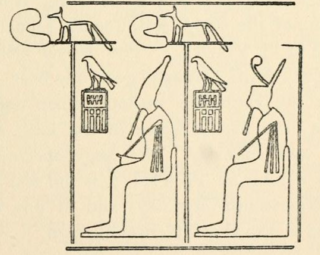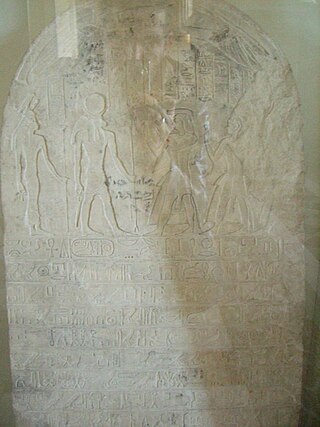
Memphis, or Men-nefer, was the ancient capital of Inebu-hedj, the first nome of Lower Egypt that was known as mḥw ("North"). Its ruins are located in the vicinity of the present-day village of Mit Rahina, in markaz (county) Badrashin, Giza, Egypt. This modern name is probably derived from the late Ancient Egyptian name for Memphis mjt-rhnt meaning "Road of the Ram-Headed Sphinxes".

In ancient Egyptian religion, Apis or Hapis, alternatively spelled Hapi-ankh, was a sacred bull or multiple sacred bulls worshiped in the Memphis region, identified as the son of Hathor, a primary deity in the pantheon of ancient Egypt. Initially, he was assigned a significant role in her worship, being sacrificed and reborn. Later, Apis also served as an intermediary between humans and other powerful deities.

In Egyptian mythology, Buchis was the deification of the kꜣ of the war god Montu as a sacred bull that was worshipped in the region of Hermonthis. In order to being chosen as the Buchis incarnation of Montu, a bull was required to have a white body and black face. When these bulls – and in later times also their mothers – died, they were mummified, and placed in a special cemetery known as the Bucheum.

Mnevis is the Hellenized name of an ancient Egyptian bull god which had its centre of worship at Heliopolis, and was known to the ancient Egyptians as Mer-wer or Nem-wer.

Saqqara, also spelled Sakkara or Saccara in English, is an Egyptian village in the markaz (county) of Badrashin in the Giza Governorate, that contains ancient burial grounds of Egyptian royalty, serving as the necropolis for the ancient Egyptian capital, Memphis. Saqqara contains numerous pyramids, including the Pyramid of Djoser, sometimes referred to as the Step Tomb, and a number of mastaba tombs. Located some 30 km (19 mi) south of modern-day Cairo, Saqqara covers an area of around 7 by 1.5 km.

Cattle are prominent in some religions and mythologies. As such, numerous peoples throughout the world have at one point in time honored bulls as sacred. In the Sumerian religion, Marduk is the "bull of Utu". In Hinduism, Shiva's steed is Nandi, the Bull. The sacred bull survives in the constellation Taurus. The bull, whether lunar as in Mesopotamia or solar as in India, is the subject of various other cultural and religious incarnations as well as modern mentions in New Age cultures.

A serapeum is a temple or other religious institution dedicated to the syncretic Greco-Egyptian deity Serapis, who combined aspects of Osiris and Apis in a humanized form that was accepted by the Ptolemaic Greeks of Alexandria. There were several such religious centers, each of which was called a serapeion/serapeum or poserapi, coming from an Egyptian name for the temple of Osiris-Apis.

Djer is considered the third pharaoh of the First Dynasty of ancient Egypt in current Egyptology. He lived around the mid 31st century BC and reigned for c. 40 years. A mummified forearm of Djer or his wife was discovered by Egyptologist Flinders Petrie, but was discarded by Émile Brugsch.
In ancient Egypt, cats were represented in social and religious scenes dating as early as 1980 BC. Several ancient Egyptian deities were depicted and sculptured with cat-like heads such as Mafdet, Bastet and Sekhmet, representing justice, fertility, and power, respectively. The deity Mut was also depicted as a cat and in the company of a cat.

The four sons of Horus were a group of four deities in ancient Egyptian religion who were believed to protect deceased people in the afterlife. Beginning in the First Intermediate Period of Egyptian history, Imsety, Hapy, Duamutef, and Qebehsenuef were especially connected with the four canopic jars that housed the internal organs that were removed from the body of the deceased during the process of mummification. Most commonly, Imsety protected the liver, Hapy the lungs, Duamutef the stomach, and Qebehsenuef the intestines, but this pattern often varied. The canopic jars were given lids that represented the heads of the sons of Horus. Although they were originally portrayed as humans, in the latter part of the New Kingdom, they took on their most distinctive iconography, in which Imsety is portrayed as a human, Hapy as a baboon, Duamutef as a jackal, and Qebehsenuef as a falcon. The four sons were also linked with stars in the sky, with regions of Egypt, and with the cardinal directions.
Prince Khaemweset was the fourth son of Ramesses II and the second son by his queen Isetnofret. His contributions to Egyptian society were remembered for centuries after his death. Khaemweset has been described as "the first Egyptologist" due to his efforts in identifying and restoring historic buildings, tombs and temples.

Usermaatre Setepenre Pami was an ancient Egyptian pharaoh of the 22nd Dynasty who ruled for 7 years. "Pami" in Egyptian, means "the Cat" or "He who belongs to the Cat [Bastet]".

Armant, also known as Hermonthis, is a town located about 19 km (12 mi) south of Thebes. It was an important Middle Kingdom town, which was enlarged during the Eighteenth Dynasty. It is located today in the Luxor Governorate on the west bank of the Nile.

The pyramid of Unas is a smooth-sided pyramid built in the 24th century BC for the Egyptian pharaoh Unas, the ninth and final king of the Fifth Dynasty. It is the smallest Old Kingdom pyramid, but significant due to the discovery of Pyramid Texts, spells for the king's afterlife incised into the walls of its subterranean chambers. Inscribed for the first time in Unas's pyramid, the tradition of funerary texts carried on in the pyramids of subsequent rulers, through to the end of the Old Kingdom, and into the Middle Kingdom through the Coffin Texts that form the basis of the Book of the Dead.
The pyramid of Pepi I is the pyramid complex built for the Egyptian pharaoh Pepi I of the Sixth Dynasty in the 24th or 23rd century BC. The complex gave its name to the capital city of Egypt, Memphis. As in the pyramids of his predecessors, Pepi I's substructure was filled with vertical columns of hieroglyphic texts, Pyramid Texts. It was in Pepi I's pyramid that these texts were initially discovered in 1880 by Gaston Maspero, though they originated in the pyramid of Unas. The corpus of Pepi I's texts is also the largest from the Old Kingdom, comprising 2,263 columns and lines of hieroglyphs.

The pyramid of Djedkare Isesi is a late 25th to mid 24th century BC pyramid complex built for the Fifth Dynasty pharaoh Djedkare Isesi. The pyramid is referred to as Haram el-Shawaf by locals. It was the first pyramid to be built in South Saqqara.

Animal mummification was common in ancient Egypt. Animals were an important part of Egyptian culture, not only in their role as food and pets, but also for religious reasons. Many different types of animals were mummified, typically for four main purposes: to allow people's beloved pets to go on to the afterlife, to provide food in the afterlife, to act as offerings to a particular god, and because some were seen as physical manifestations of specific deities that the Egyptians worshipped. Bastet, the cat goddess, is an example of one such deity. In 1888, an Egyptian farmer digging in the sand near Istabl Antar discovered a mass grave of felines, ancient cats that were mummified and buried in pits at great numbers.

Tyti was an ancient Egyptian queen of the 20th Dynasty. A wife and sister of Ramesses III and possibly the mother of Ramesses IV.

The Serapeum of Saqqara was the ancient Egyptian burial place for sacred bulls of the Apis cult at Memphis. It was believed that the bulls were incarnations of the god Ptah, which would become immortal after death as Osiris-Apis, a name which evolved to Serapis (Σέραπις) in the Hellenistic period, and Userhapi (ⲟⲩⲥⲉⲣϩⲁⲡⲓ) in Coptic. It is part of the Saqqara necropolis, which includes several other animal catacombs, notably the burial vaults of the mother cows of the Apis.

The pyramid of Nyuserre is a mid-25th-century BC pyramid complex built for the Egyptian pharaoh Nyuserre Ini of the Fifth Dynasty. During his reign, Nyuserre had the unfinished monuments of his father, Neferirkare Kakai, mother, Khentkaus II, and brother, Neferefre, completed, before commencing work on his personal pyramid complex. He chose a site in the Abusir necropolis between the complexes of Neferirkare and Sahure, which, restrictive in area and terrain, economized the costs of labour and material. Nyuserre was the last king to be entombed in the necropolis; his successors chose to be buried elsewhere. His monument encompasses a main pyramid, a mortuary temple, a valley temple on Abusir Lake, a causeway originally intended for Neferirkare's monument, and a cult pyramid.

















